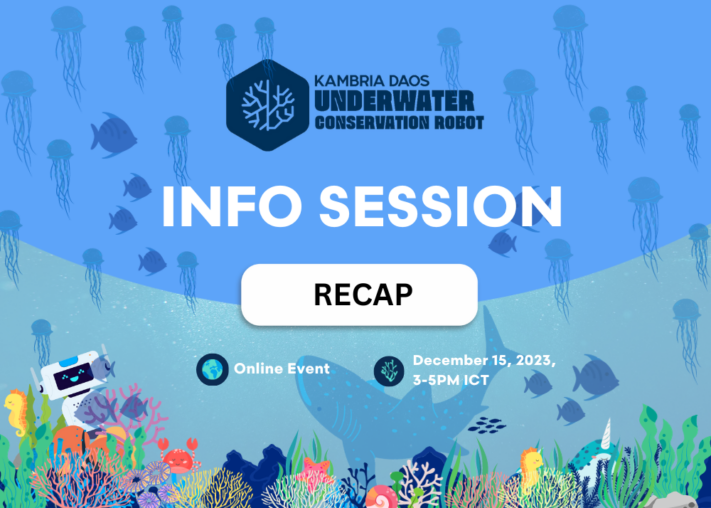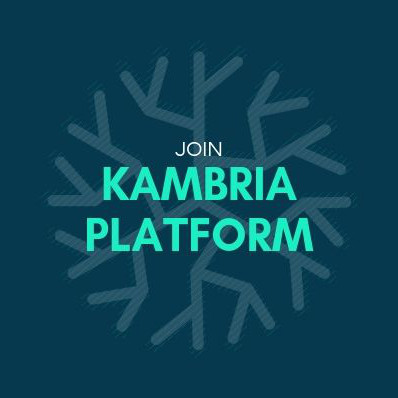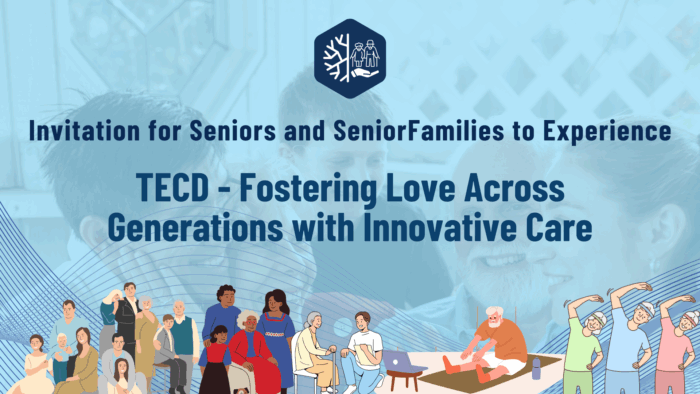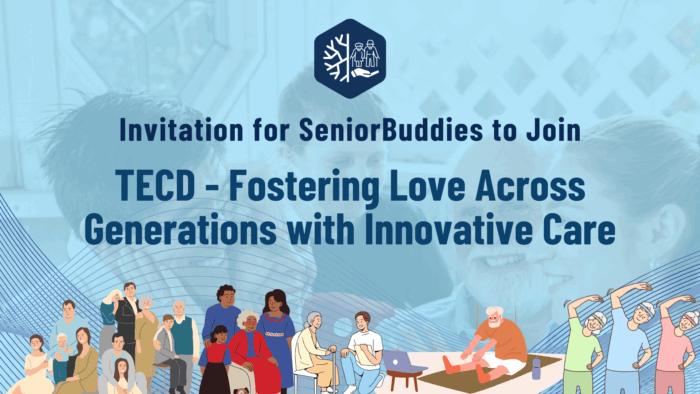Kambria has successfully organized the Underwater Conservation Robot DAO (UCRD) - Info Seminar Session on December 15th, 2023.
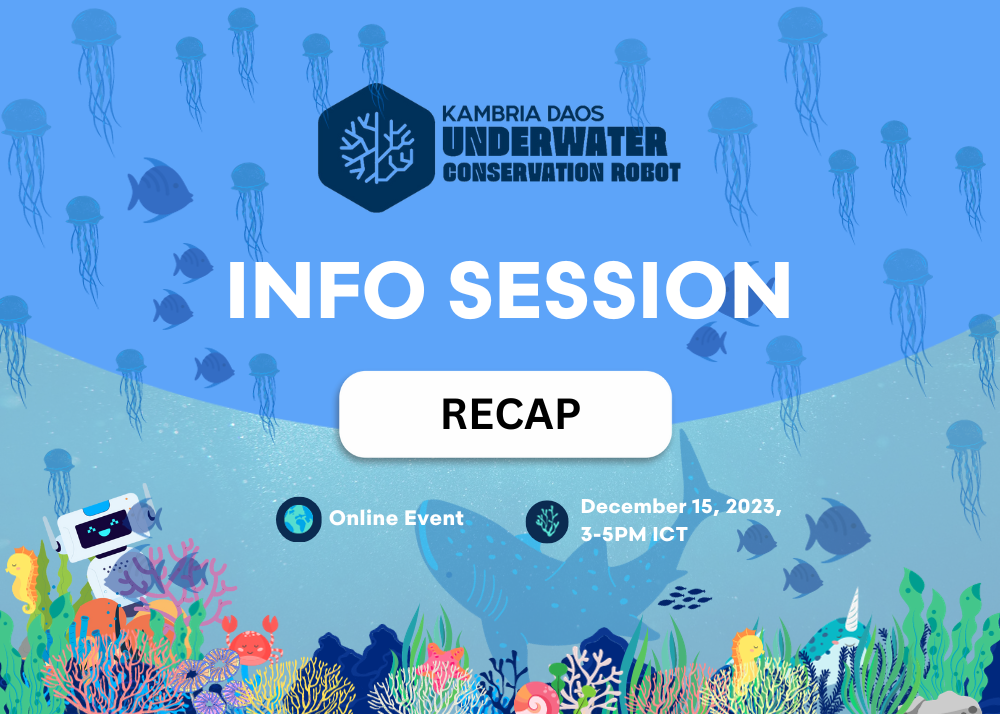
In this session, in addition to sharing more information about this initiative and our partnership invitations, we would like to take this opportunity to raise public awareness about marine environmental protection and conservation actions. We aim to foster a shared experience among supporters, encouraging them to share their own stories.
Underwater Conservation Robots, also known as underwater drones or remotely operated vehicles (ROVs), play a critical role in marine conservation efforts. Motivated by recognizing this crucial facet, we are excited to introduce the Underwater Conservation Robot DAO. We are truly thankful for all the people accompanying us on this amazing journey!
Table of Contents
- 1. Kambria Introduction:
- 2. Guest Talks:
- The first sharing “Ocean Conservation and Its Vital Role in Shaping a Sustainable Future” was from Mr. Roger Maslin, CEO of Ocean Conservation Trust.
- The second topic, “A decade journey to safeguard Pakistan's marine ecosystems and small-scale fisheries”, was shared by Mr. Shoaib Abdul Razzaque, a marine biologist possessing a master’s degree in Marine Sciences and a Coordinator of a marine program at WWF - Pakistan.
- The next sharing was from Ms. Mary Jane Lamoste, a social entrepreneur and trained marine biologist who is passionate about raising awareness on Sustainable Development Goals, with the topic “The Impact of Upcycling on Marine Conservation: From Fashion Waste to Ocean Art”.
- The last sharing was from Mr. Sencer Yazici, a Robotics & Embedded Software Engineer at Robottimo LLC, with the topic "Your motivation and passion when working in the field of underwater vehicles”.
- 3. Spark Sharing:
- 3.1. Could you please share with us a time when you, either by yourself or with your team, participated in a Marine Conservation Campaign or a Marine Conservation volunteer project?
- 3.2. Could you please share the obstacles/troubles that you have overcome or the most memorable moments on the Marine Conservation journey?
- 3.3. If we organize some community activities/campaigns to raise public awareness, which activity do you think we should do?”
- 3.4. If you have an underwater conservation robot, how do you want it to help you in marine conservation?
- 4. Kambria would also like to share the Q&A section:
-
The first five questions are from Nabila Irsyam:
- Mr. Shoaib Abdul Razzaque - The 1st question is “What is the latest status of coral bleaching globally and where can I get/access the data?"
- Mr. Shoaib Abdul Razzaque - The 2nd question is “Where is the most severe bleaching of global coral reef? How many percent/km?”
- Ms. Mary Jane Lamoste - The 3rd question is “What is the best framework to create a marine conservation for coral reefs in tropical seas like Bali in Indonesia?”
- Ms. Mary Jane Lamoste - The 4th question is “Who is the most responsible person to handle coral reef conservation?”
- Mr. Scencer Yazici - The 5th question is “What should we do to prevent coral bleaching in the future?”
- The last question is from Tri Wahyu Prabowo:
-
The first five questions are from Nabila Irsyam:
- 5. About Underwater Conservation Robot DAO’s Next Milestones:
- - - - - 🔹 - - - - -
1. Kambria Introduction:
Ms. Lien Cao, CEO of Kambria, kicked off the Info Session by sharing the overview of Kambria, Kambria DAOs, and the Underwater Conservation Robot DAO.
Kambria & Kambria DAOs Introduction:
- Kambria is an open innovation platform dedicated to shaping the future of technology. Focused on deep tech areas such as AI, robotics, blockchain, AR, VR, and IoT, Kambria aims to democratize and decentralize technology in ownership, development, manufacturing, commercialization, and enforcement.
- Kambria DAOs is a way for the community to co-own a technology. Kambria is going to launch the first 4 DAOs, which are Pet Care Robot DAO (PCRD), Mine Clearing Robot DAO (MCRD), Ocean Cleanup Robot DAO (OCRD), and Underwater Conservation Robot DAO (UCRD).
Underwater Conservation Robot DAO:
In the following section, Ms. Lien shared more details about Underwater Conservation. Through the research, the presentation noted key facts that motivate Kambria to take action.
The escalating threats to marine ecosystems, marked by pollution crises, coral reef degradation, and biodiversity loss, demand urgent intervention.
Alarming statistics reveal a 50% decline in global coral reefs, with projections foreseeing up to a 90% loss by midcentury due to factors like coral bleaching, pollution, and climate change.
Recognizing the severity of these challenges, we've concluded that immediate action is imperative. We are launching the Underwater Conservation Robot DAO to respond to these pressing environmental issues. This initiative harnesses cutting-edge technology, including underwater robots, to actively address pollution, expedite coral reef restoration, and monitor the health of underwater ecosystems. Some suggested features include water pollution monitoring, temperature tracking, automated coral reef restoration, and community-oriented solutions.
The UCRD has four main phases:
Phase 1: Develop an Underwater Conservation Robot Solution
Phase 2: Implement the solution
Phase 3: Create community movement with UCRD Gamification
Phase 4: Speed up the work via community
Potential collaborations that Kambria would like to propose include:
- Dev Teams, particularly the Developers who will propose the solution to be built. The proposal must include an introduction to the team's background and capabilities, demonstration works, a development plan and a quotation.
- Services Partners, especially organizations, projects who are already in the chain, or doing marine conservation services.
- For Service Partners, we would love to have them participate in the solution development phase to give out the needs and test the solution.
- Later on, once the product is finalized, they can help with the implementation of their services to the robot.
- Fund Contributors, especially people who come together to participate in these technology solutions. The financial data highlighted by Ms. Lien during the presentation revealed the substantial market potential of the underwater exploration robot industry. With a current size of $3.5 billion in 2021 and projected growth to $8 billion by 2027, this sector offers significant opportunities. Furthermore, she explained the allocation of DAO funds and revenue sharing in accordance with the Kambria DAO financial framework.
- Community Partners, people who are spreading the good works about DAO solutions. They can join us in publicizing awareness activities such as cross-sharing helpful information and co-organizing community events. They can also serve as DAO Hubs to implement services when the solutions are ready for this stage.
Ms. Lien concluded the presentation by informing the community about the next activities of Underwater Conservation Robot DAO:
- Proposal Submission: Dev teams are invited to submit proposals by July 8, 2024, showcasing their team profile, relevant experience, and development plan.
- Online DAO Launch Event: An online event in August will feature dev teams presenting their proposals, engaging in Q&A, and kicking off a fundraising campaign for the first product cycle.
***
2. Guest Talks:
Kambria would love to share highlights from the meaningful stories and inspirational journeys shared by our beloved guests:
The first sharing “Ocean Conservation and Its Vital Role in Shaping a Sustainable Future” was from Mr. Roger Maslin, CEO of Ocean Conservation Trust.
Mr. Roger Maslin, the CEO of the Ocean Conservation Trust, presented a comprehensive overview of the organization's approach to ocean conservation during his recent presentation. He shared that the team focuses on three core programs: Ocean Experiences, Ocean Advocacy, and Ocean Habitats, all with the overarching goal of creating a healthier ocean.
The Ocean Experiences program centers around the National Marine Aquarium, the flagship initiative aimed at captivating audiences of all ages with the wonders of marine life. Meanwhile, the Ocean Advocacy initiative, known as #thinkocean aims to connect people with the ocean and raise awareness about the vital connection between humans and the ocean. The Ocean Habitats program, known as "Blue Meadows" takes a hands-on approach to protecting, regenerating, and restoring seagrass, a crucial but endangered component of ocean ecosystems.
Seagrass, as Mr. Maslin explained, is not only the ocean's sole flowering plant but also a linchpin for biodiversity, acting as a vital nursery for fisheries. Despite their ecological importance, seagrass habitats are under severe threat, particularly in the UK, where 90% have been lost due to human activities.
Mr. Roger Maslin shared the solution comprises three steps: protection, restoration, and scaling.
- The protection phase involves community engagement, utilizing distinctive markers to identify seagrass meadows, and leveraging technology such as the Savinavi app to guide mariners away from vulnerable areas.
- Moving into the restoration phase, Mr. Maslin shared the Trust's exploration of innovative techniques like mass seedling production and mechanized approaches to reduce costs associated with diver interventions. Monitoring and evaluation are integral, with a focus on seagrass growth, biodiversity, and carbon storage.
- Stakeholder engagement emerged as a key theme, with a call to involve communities of all ages, from schools to senior citizens, in the conservation efforts. The final step revolves around scaling the successful restoration model, sharing knowledge globally to restore seagrass levels to those observed in the 1930s.
Mr. Maslin concluded with a sense of urgency, pointing out the limited time available in the face of climate change. He extended an invitation for collaboration, emphasizing that the collective efforts of all concerned individuals are crucial in tackling this pressing environmental challenge.
The second topic, “A decade journey to safeguard Pakistan's marine ecosystems and small-scale fisheries”, was shared by Mr. Shoaib Abdul Razzaque, a marine biologist possessing a master’s degree in Marine Sciences and a Coordinator of a marine program at WWF - Pakistan.
Mr. Shoaib Abdul Razzaque, a marine biologist and Coordinator of the marine program at WWF - Pakistan, shared insights into a decade-long journey focused on safeguarding Pakistan's marine ecosystems and small-scale fisheries. In his engaging presentation, Mr. Razzaque emphasized the importance of a participatory approach when working with fisheries communities, highlighting positive outcomes from his experiences.
The journey began in 2011 when Mr. Razzaque joined a scientific expedition on a ship for marine observation. Subsequently, in 2012, he joined WWF as a research assistant, where he collected biological, environmental, and chemical data. Throughout the years, he actively engaged with fishing communities, implementing bycatch reduction tools, participating in rescues of endangered species like dolphins and marine turtles, and conducting workshops and surveys.
Pakistan's marine ecosystem boasts rich biodiversity, including various species of mangroves, corals, and marine life. However, the challenges faced by fishing communities and marine biodiversity are significant. Mr. Razzaque addressed the need to focus on the conservation of megafauna and endangered, protected, and threatened (ETP) species. He highlighted the potential threats posed by tuna fishing fleets and the importance of conservation efforts.
A key aspect of his presentation involved the collaboration with fishermen to develop and implement low-cost technologies for reducing bycatch, specifically for turtles and dolphins. This initiative proved successful, leading to a significant reduction in the mortality of dolphins. The presentation showcased how voluntary fishermen played a crucial role in reporting and addressing issues such as whale strandings and entanglements.
Mr. Razzaque also discussed the importance of data collection and reporting, showcasing how working closely with fishermen resulted in increased compliance in reporting to regional fisheries organizations. Through trust-building and social behavioral changes, the project achieved success in the safe handling and release of various marine species.
Mr. Razzaque discussed future projects aimed at improving fishing techniques, assessing cetacean bycatch, and transitioning to digital logbooks. He also introduced novel approaches, such as machine learning and artificial intelligence, to improve species-level reporting.
In conclusion, the presentation highlighted the positive impact of collaborative efforts between marine biologists and fishing communities, showcasing tangible results in marine conservation. Mr. Razzaque expressed gratitude to donors and emphasized the collective responsibility of ensuring the health and sustainability of our oceans.
The next sharing was from Ms. Mary Jane Lamoste, a social entrepreneur and trained marine biologist who is passionate about raising awareness on Sustainable Development Goals, with the topic “The Impact of Upcycling on Marine Conservation: From Fashion Waste to Ocean Art”.
Ms. Mary Jane Lamoste shared insights into her journey from marine conservation to upcycling as a means of addressing the environmental impact of fashion waste on marine ecosystems. She expressed solidarity with global conservation efforts, particularly highlighting the challenges faced in the Philippines and Indonesia.
She began by outlining the typical lifecycle of a pair of jeans and highlighting the astronomical environmental costs connected to their manufacture. She disclosed that a single pair of jeans uses up to 1500 hours of electricity, 4000 liters of water, and 33.4 kilograms of carbon dioxide during its lifetime, based on a case study by Levi's.
Ms. Lamoste then shared the alarming statistics of the fashion industry, citing the documentary "The True Cost." She pointed out that the world currently consumes 80 billion new clothing items annually, a 400% increase from 20 years ago. In the U.S. alone, 11.3 tons of textiles are discarded each year, contributing to the global waste crisis.
The environmental impact of fast fashion, particularly the release of microplastics and toxic chemicals during clothes washing, was discussed. Ms. Lamoste highlighted the consequences of such pollutants, including water contamination and the rise of diseases in regions like India and Bangladesh.
Transitioning to the core of her presentation, Ms. Lamoste introduced the concept of upcycling as a solution. She detailed the formation of her social enterprise, Tagpi-Tagpi, which focuses on transforming fashion waste into art while providing economic opportunities for underprivileged women in coastal communities. The initiative not only extends the lifespan of fabric but also promotes circular economy principles.
Throughout the presentation, Ms. Lamoste emphasized the transformative impact of upcycling on the lives of these women, empowering them to explore new talents and skills. She underlined the importance of community building and showcased the success stories of women who transitioned from traditional roles to becoming entrepreneurs and environmental advocates.
In conclusion, Ms. Mary Jane Lamoste expressed her commitment to furthering the United Nations Sustainable Development Goals (SDGs) through Tagpi-Tagpi. She invited collaboration with youth movements and other organizations while stressing the importance of raising awareness about the environmental impact of fashion waste on marine ecosystems. The presentation concluded with a call to action, urging collective efforts to address the challenges faced by our oceans.
The last sharing was from Mr. Sencer Yazici, a Robotics & Embedded Software Engineer at Robottimo LLC, with the topic "Your motivation and passion when working in the field of underwater vehicles”.
Mr. Sencer Yazici provided a captivating presentation on his journey in the field of robotics, particularly focusing on underwater robotics and the challenges his team faced.
Mr. Yazici started by expressing his gratitude for the excellent presentations given by others and then introduced his topic, "A Look at Current Ocean Cleanup Robots".
He shared his background, graduating from Istanbul Technical University with a major in controls and automation engineering. His passion for robotics led him to co-found the ITU ROV team in 2017, a remotely operated vehicle (ROV) team, which later evolved into the ITU AUV team, an autonomous underwater vehicle (AUV) team in 2019. With the guidance of Associate Professor Bigot Sak, both teams, comprising up to 25 members, successfully developed underwater robots, even though they initially needed more knowledge in the field.
Mr. Yazici presented an image from 2017 when his team won the first prize in the ITU ROV team, propelling them to the ROV Turkey regional competition. Despite their initial lack of knowledge, the team's passion and dedication led to success, winning first place in the ITU AUV team for two consecutive years. The ITU AUV team, focused on autonomous systems, faced challenges in learning and fundraising but ultimately developed a functional vehicle.
He shared challenges during COVID-19 that he and his team faced. The impact of the COVID-19 pandemic on their activities, including transitioning to online meetings and facing restrictions, was discussed. Despite the challenges, the team persevered, and as soon as restrictions were lifted, they resumed testing and working on their robots.
He continued speaking of his journey after the success of the Singapore AUV Challenge. In 2021, the team participated in RoboSub 2021, transitioning to an online competition due to COVID-19, and became finalists. The Singapore AUV Challenge for the same year was canceled, impacting their planned participation. The following year, the team achieved success by placing first in the Singapore AUV Challenge 2022, marking their first international on-site prize.
He went on by sharing his next adventure with new challenges. Mr. Yazici took on the role of mentoring the ITU AUV team in developing unmanned surface vehicles. The team achieved success in the New York Autonomy Challenge 2023, securing first place.
Mr. Yazici concluded his presentation by summarizing his journey as a robotics enthusiast and mentor. He emphasized the importance of building technology that adds value to the community and contributes to a better future for the planet and oceans. His final message to the community was to "dive into the future," encouraging others to explore and contribute to the advancement of technology for the benefit of the planet.
3. Spark Sharing:
3.1. Could you please share with us a time when you, either by yourself or with your team, participated in a Marine Conservation Campaign or a Marine Conservation volunteer project?
Mr. Sencer Yazici shared with us his journey along with his team. In the early days, their knowledge of underwater robotics, particularly marine robotics, was quite limited. Their primary challenge was self-improvement, as they aimed to address the community’s evolving needs. To enhance their capabilities, they actively participated in various events that provided invaluable opportunities to test their vehicles in open sea conditions. However, the windy and somewhat hazardous conditions of the Bosphorus in Istanbul posed challenges for testing, limiting their ability to conduct certain experiments in a student-led capacity.
Despite these obstacles, their overarching goal was to develop an exploration robot capable of mapping the seafloor and detecting specific biological entities underwater. This focus on advancing marine exploration became their driving force. Their involvement in these events was more rooted in the technical aspects, concentrating on effectively delivering solutions that cater to people's needs. Over time, their technology has become the foundation for various activities; and he also shares that witnessing the impactful applications of what Kambria has built is truly rewarding.
The journey has not always been without challenges, but the dedication to building a better future through innovative exploration robots has remained at the forefront of their endeavors. The technology they've developed is now actively contributing to valuable works and activities in the realm of marine robotics.
3.2. Could you please share the obstacles/troubles that you have overcome or the most memorable moments on the Marine Conservation journey?
Mr. Roger Maslin
In Mr. Roger Maslin's speech, he emphasized a critical challenge faced by the UK - the disconnection from the ocean. He identified this loss of connection as a fundamental issue that needs urgent attention. The primary goal is to rekindle people's awareness and understanding of their link with the ocean. To address this, the Ocean Conservation Trust focuses on promoting ocean literacy, aiming for a more informed public about the reciprocal impacts between human lives and the ocean.
The concept of "marine citizenship" is introduced as a central theme, encapsulated in their ocean advocacy program called "Think Ocean". The program's objective is clear: conservation revolves around people, and establishing an emotional connection with the ocean is crucial. The behavioral pathway outlined involves experiencing and participating, leading to emotional engagement, discovery and learning, and ultimately fostering a connection that drives positive action.
The Ocean Conservation Trust employs a comprehensive approach, working both top-down and bottom-up. Collaboration with governments and the United Nations seeks to enhance humanity's relationship with the ocean at a broader level. Locally, the organization leverages its National Marine Aquarium, engaging over 300,000 visitors annually to influence behaviors and deepen connections with the ocean.
Mr. Maslin emphasized the importance of campaigns over the next 18 months, aimed at encouraging people to "think ocean." Additionally, he highlighted the designation of Plymouth Sound as the UK's first national marine park, presenting a unique opportunity to place the ocean at the heart of the city and enhance ocean literacy in the southwest of England.
In conclusion, the overarching message is clear: the imperative is to bridge the gap between humanity and the ocean, reigniting a connection that is vital for the health and well-being of the planet's oceans. The organization's multifaceted approach, from national campaigns to local initiatives, is geared towards making a significant impact on ocean literacy and conservation.
Mr. Shoaib Abdul Razzaque
The next sharing was from Mr. Shoaib Abdul Razzaque. In his speech, he reflected on the complexity of addressing challenges in fisheries, emphasizing the need for improved monitoring, surveillance, and compliance at various levels of fisheries management. He underscored the importance of considering the livelihoods of fishermen while implementing conservation measures. Highlighting the example of fishermen cutting their fishing gear for the release of marine animals, he raised the question of what support awaited them from the government.
Mr. Razzaque shared insights into navigating the marine conservation journey, acknowledging the numerous challenges involved, from collaborating with fishing communities to overcoming bureaucratic hurdles and securing funding. He stressed the importance of maintaining persistent communication with fishermen without losing their interest and advocated for recognizing and celebrating their efforts in project advocacy.
The memorable moments for Mr. Razzaque stemmed from successful wildlife releases and witnessing coastal communities adapting to sustainable practices, promoting the overarching goal of sustainable fisheries. He expressed joy in seeing fishermen enjoy a good catch that contributed to their livelihoods while reinforcing the impact of conservation efforts on marine ecosystems.
A particularly poignant part of Mr. Razzaque's journey involved the unexpected revelation that the incentives provided to fishermen for data collection contributed to their happiness in ways he hadn't anticipated. He shared a heartwarming story of how the fishermen used the limited amount of money provided for incentives to celebrate weddings within their community. This unexpected positive impact on the fishermen's lives added a personal and emotional dimension to the conservation efforts.
In conclusion, Mr. Shoaib Abdul Razzaque's talk emphasizes the multifaceted nature of fisheries management, the challenges of marine conservation, and the profound impact that thoughtful and community-oriented conservation initiatives can have on the lives of coastal communities.
3.3. If we organize some community activities/campaigns to raise public awareness, which activity do you think we should do?”
Ms. Mary Jane Lamoste
In Ms. Mary Jane Lamoste's insightful speech, she provided guidance on initiating community-focused initiatives for marine conservation. She outlined two key approaches for individuals interested in making a positive impact. The first involved identifying existing community issues and starting with volunteering. Ms. Lamoste suggested participating in activities like coastal cleanups as an easy entry point. This allows individuals to explore their interests and meet like-minded people while contributing to a one-time community activity.
The second approach, which she found more empowering, was starting one's own campaign. Ms. Lamoste shared her journey of wanting to work in the marine environment but not in research, leading her to identify her strength in providing opportunities for women. She advocated for exploring social enterprise, even without a business background, by reaching out to people for guidance on creating business and project proposals. Collaborating with a team and prototyping skills are crucial steps in this process.
Ms. Lamoste emphasized the importance of building relationships with communities before launching a campaign, making it easier for them to accept new ideas. She shared her experience of creating toys related to the ocean, paying communities for their involvement, and gauging tourist interest. The goal is to trigger curiosity and engagement, gradually progressing to the next level of involvement.
The speech concluded with a valuable insight: the learning process is continuous. Ms. Lamoste stresses that growth is synonymous with learning, and every short or long-term campaign provides an opportunity to acquire new knowledge. She encouraged the audience not to fear trying something new, emphasizing that there is no harm in attempting to make a positive impact rather than regretting inaction. Ms. Lamoste's speech inspires individuals to take proactive steps towards marine conservation, promoting a sense of empowerment and continuous learning.
Mr. Scencer Yazici
In the next share of Mr. Scencer Yazici, he shed light on the significance of student competitions and challenges in robotics for raising public awareness. From the perspective of a robotics enthusiast, Mr. Yazici emphasized the positive impact that student challenges have on the younger generation, who are the future engineers. These competitions provide a platform for students to showcase their abilities, fostering excitement and enthusiasm among participants. The challenges, according to Mr. Yazici, allow students to develop solutions and engineer their own approaches to real-world problems.
While the competitions he mentioned may not be directly linked to underwater conservation challenges, Mr. Yazici saw them as contributing to the broader ideology of making a positive impact. He envisioned a future where competitions specifically targeting underwater conservation challenges would be extremely useful and beneficial to the community. As someone involved in mentoring teams, Mr. Yazici expressed a personal commitment to encouraging teams to participate in such competitions, viewing it as a way to contribute to building a better future.
In conclusion, Mr. Scencer Yazici's speech highlights the transformative power of student challenges in robotics, not only as a means of skill development but also as a pathway to instill a sense of responsibility and purpose in the younger generation. He envisioned a future where robotics competitions can directly address challenges related to underwater conservation, fostering innovation and positive change in the community.
3.4. If you have an underwater conservation robot, how do you want it to help you in marine conservation?
Mr. Shoaib Abdul Razzaque
Mr. Shoaib Abdul Razzaque's comprehensive speech delved into his interest in marine conservation projects and the potential applications of underwater robotics in this field. Mr. Razzaque highlighted his previous efforts, including a proposal submitted to the UN for innovation funding, which unfortunately did not secure support. However, he expressed a strong desire to explore underwater robotics for studying coral communities in detail, especially in areas where diving is considered risky or challenging.
If equipped with sensors, Mr. Razzaque envisioned underwater robots detecting underwater chemistry to analyze the impact of climate change on water ecosystems. He emphasized the importance of robotics being powered with artificial technology, allowing for regular monitoring of coral growth, species identification, and health assessment, particularly focusing on events like coral bleaching.
Beyond coral reefs, Mr. Razzaque saw underwater robotics as a versatile and innovative tool for marine conservation. He proposed its use in comprehensive surveys to monitor reefs, assess biodiversity, and count populations of sharks and whales. According to Mr. Razzaque, robotics can contribute to regional databases by collecting images of distinct patterns in sharks' bodies.
Mr. Razzaque also considered the potential role of underwater robotics in addressing environmental issues, such as collecting underwater garbage and aiding in the aquaculture of coral reefs by planting them within the ecosystem. He emphasized the importance of aligning the use of robotics with specific goals and interests, stressing that the motive behind its application should be clear.
In conclusion, Mr. Shoaib Abdul Razzaque envisioned underwater robotics as a powerful tool for monitoring marine protected areas (MPAs) and systematically assessing underwater biodiversity. His speech reflects a thoughtful and strategic approach to leveraging technology for marine conservation, showcasing the diverse possibilities that underwater robotics can offer in safeguarding our oceans.
Mr. Roger Maslin
Mr. Roger Maslin emphasized the multifaceted applications of underwater robots, foreseeing their pivotal role in addressing various challenges in marine conservation. He acknowledged the global initiatives utilizing drones to measure water chemistry and minimize bycatch, showcasing the expanding landscape of technology in ocean-related projects.
Mr. Maslin then zoomed in on the specific application of ROVs in his organization's Blue Meadows program. The primary objectives of this program include locating seagrass, monitoring its health, and measuring the impact of restoration efforts. He introduced their ROV, which utilizes military technology to capture precise seabed images, creating comprehensive maps. This ROV becomes a powerful tool for accurately assessing the outcomes of their seagrass restoration initiatives.
Mr. Maslin shared an intriguing aspect of their work, aiming to create a "blue carbon credit" as a funding mechanism for restoration. Proving the additional value of their restoration efforts is crucial to attract investors. The ROV's capability to measure and quantify seagrass growth becomes instrumental in providing tangible evidence of the positive impact generated by their restoration projects.
In summary, Mr. Roger Maslin showcased how underwater robotics, particularly ROVs, play a vital role in monitoring and evaluating the success of marine restoration initiatives. His speech underscores the practical use of technology in addressing environmental challenges and highlights the innovative approaches taken by his organization to secure funding for marine conservation efforts.
4. Kambria would also like to share the Q&A section:
When introducing this event to the community, we received interesting questions from them, seeking answers from Kambria and our esteemed guests.
The first five questions are from Nabila Irsyam:
Mr. Shoaib Abdul Razzaque - The 1st question is “What is the latest status of coral bleaching globally and where can I get/access the data?"
Mr. Shoaib Abdul Razzaque began by addressing the current status of coral bleaching and the challenges associated with accessing relevant information. He highlighted the widespread efforts of various global organizations, including ArcGIS Dashboard, NOAA Coral Reef Watch, ReefBase, Global Reef Record, Coral Reef Monitoring Network, Nature's Conservancy Reef Resilience Network, Coral Health Atlas, Integrated Coral Observatory Network, and the Australian Institute of Marine Sciences.
In emphasizing a neutral perspective, Mr. Razzaque encouraged individuals to explore these databases based on their specific interests, particularly those inclined towards graphical representations of data. ArcGIS Dashboard is singled out as a noteworthy tool, capable of providing graphical insights from 230 stations worldwide through interactive maps and real-time or historical data.
The speech then shifted to a discussion about the significant 2014 and 2017 global Coral Reef bleaching event, documented as the longest, most widespread, and most damaging occurrence of its kind. The Great Barrier Reef, along with reefs in the Caribbean and Hawaii, experienced global bleaching events, impacting over 75% of Earth's tropical reefs. Nearly 30% of these reefs reached mortality levels during the period between 2014 and 2017.
To conclude, Mr. Razzaque advised listeners to consult relevant documents and online databases for comprehensive insights into the impacts of coral bleaching.
Mr. Shoaib Abdul Razzaque - The 2nd question is “Where is the most severe bleaching of global coral reef? How many percent/km?”
Mr. Shoaib Abdul Razzaque also helped to share answers for this question. He opened by referencing an article named “Severe coral bleaching along 500 kilometres of Great Barrier Reef’ published on The Sydney Morning Herald from two months ago, discussing their team's 2012 survey of 91% of the Great Barrier Reef. It revealed severe bleaching events affecting 60% of coral along a 500-kilometer stretch, particularly in areas considered vulnerable due to climatic changes.
Mr. Razzaque introduced a critical perspective, questioning whether the focus on the Great Barrier Reef was due to its prominence in news and online communication. He highlighted the possibility of unmonitored areas facing similar issues, prompting the audience to consider the broader impact of coral bleaching beyond well-publicized regions.
In addition, he addressed a global perspective, noting that coral bleaching events have become five times more common globally over the past 40 years. The emphasis shifted from the vulnerability of the Great Barrier Reef to the broader need for understanding and monitoring the real impacts on underwater communities, urging a comprehensive approach beyond specific locations.
Ms. Mary Jane Lamoste - The 3rd question is “What is the best framework to create a marine conservation for coral reefs in tropical seas like Bali in Indonesia?”
Ms. Mary Jane Lamoste underscored the importance of aligning coral reef research methods with country-specific policies, citing Bali as an example of varying restrictions and technologies. Drawing from her experience, she noted the repercussions of data misalignment with government standards, emphasizing the need for compliance.
Ms. Lamoste stressed the crucial role of stakeholder consultation in coral reef research planning, deeming it the most vital aspect. This collaborative engagement ensured a comprehensive and well-informed approach, enhancing the overall effectiveness and relevance of the research conducted in coral reef ecosystems.
Ms. Mary Jane Lamoste - The 4th question is “Who is the most responsible person to handle coral reef conservation?”
Ms. Mary Jane Lamoste also shared her answer to this question. She addressed a fundamental question regarding responsibility in coral reef conservation, extending her perspective to encompass marine conservation as a whole. She emphasized that the responsibility is a collective effort involving various stakeholders, emphasizing the symbiotic relationship between those with local knowledge and those with scientific expertise.
Ms. Lamoste stressed the crucial role of communities, who bear firsthand the impact of environmental changes, such as severe weather conditions and strong typhoons. While scientific data provides valuable insights, she highlighted the indispensable role of local communities in implementing conservation measures. This perspective challenges the notion of a single responsible entity and underscores the need for collaboration and synergy among diverse stakeholders.
In summary, Ms. Mary Jane Lamoste advocated for a collaborative and networked approach to marine conservation. She asserted that responsibility lies within a collective effort, involving local communities, scientific experts, and governmental bodies, all working in harmony to safeguard coral reefs and address broader marine conservation challenges.
Mr. Scencer Yazici - The 5th question is “What should we do to prevent coral bleaching in the future?”
From Mr. Scencer Yazici’s expertise in robotics and technology, he delved into the transformative potential of autonomous systems, particularly robotic technology, in the realm of conservation activities. He underscored the key role that these technological marvels can play, in addressing coral bleaching and in a broader spectrum of conservation events across both surface and underwater environments.
One of the pivotal advantages highlighted by Mr. Yazici is the unparalleled efficiency of autonomous robots, capable of operating 24/7 without the constraints that human involvement might pose. He emphasized the sustainability of robotic systems in terms of resource utilization and funding, making them a viable and enduring solution for continuous conservation efforts.
Moreover, Mr. Yazici articulated the distinct advantage of robotic systems in executing tasks with remarkable speed and precision. The ability to instruct robots with specific commands in milliseconds enhances their effectiveness in completing tasks, surpassing the capabilities of human counterparts. This technical proficiency, he noted, requires expertise in development but promises superior task execution once established.
A crucial aspect highlighted by Mr. Yazici is the potential for autonomous systems to explore and operate in deeper environments, areas that may pose risks to human safety. This extended reach into previously inaccessible depths opens new frontiers for conservation efforts, contributing to a comprehensive understanding of marine ecosystems.
In summary, Mr. Scencer Yazici advocated for the integration of robotic technology as a valuable resource to build a better future for ocean environments. His speech envisioned a collaborative and sustained effort, harnessing the efficiency, precision, and depth-reaching capabilities of autonomous systems to advance conservation initiatives and address the challenges faced by marine ecosystems.
The last question is from Tri Wahyu Prabowo:
Ms. Lien Cao - The question is “Developing underwater robots requires a lot of resources and funds. How do we convince conventional conservationists that applying robots for marine conservation is more profitable both in terms of finances and the effects on the environment itself?”
In Ms. Lien Cao’s speech, she shed light on the critical issue of coral reef conservation and the instrumental role that robotics can play in addressing this urgent problem. The impetus for a robotics solution, she emphasized, emanates from the conservationists themselves, driven by the pressing need to accelerate the pace of conservation work.
She underscored the alarming statistics surrounding coral loss, revealing that the world has already lost 50% of its coral, with projections indicating a staggering 90% loss by midcentury. The gravity of this situation is compounded by the fact that the recovery of coral reefs can span years to decades, necessitating a swift and efficient approach to conservation.
Highlighting the significance of coral reefs, Ms. Lien Cao emphasized that they serve as the habitat for 25% of marine species, playing a pivotal role in fostering marine biodiversity. Beyond their ecological importance, coral reefs also harbor potential medicinal resources crucial for addressing ailments such as cancer and infections.
The crux of Ms. Cao's message revolves around the potential of robotics to expedite coral reef conservation efforts. By accelerating these initiatives, she contended, we can create a more conducive environment for marine species to thrive and unlock valuable medicinal resources essential for human well-being.
5. About Underwater Conservation Robot DAO’s Next Milestones:
- Jul 8, 2024: Dev Team Proposal submission
- Aug 16, 2024: Online DAO Launch event with key points including:
- Dev Teams present proposals with Q&A from Community & Experts
- Kickstart the fundraising on XDAO - How to join
- Aug 23, 2024: Token Sale Alpha Campaign for the 1st product cycle and Ocean Explorers NFT Collection Sale
Rewatch this session at below:
